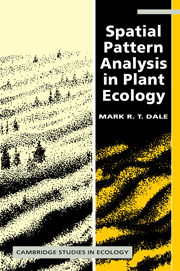Book contents
- Frontmatter
- Contents
- Preface
- 1 Concepts of spatial pattern
- 2 Sampling
- 3 Basic methods for one dimension and one species
- 4 Spatial pattern of two species
- 5 Multispecies pattern
- 6 Two-dimensional analysis of spatial pattern
- 7 Point patterns
- 8 Pattern on an environmental gradient
- 9 Conclusions and future directions
- Bibliography
- Glossary of abbreviations
- List of plant species
- Index
8 - Pattern on an environmental gradient
Published online by Cambridge University Press: 04 December 2009
- Frontmatter
- Contents
- Preface
- 1 Concepts of spatial pattern
- 2 Sampling
- 3 Basic methods for one dimension and one species
- 4 Spatial pattern of two species
- 5 Multispecies pattern
- 6 Two-dimensional analysis of spatial pattern
- 7 Point patterns
- 8 Pattern on an environmental gradient
- 9 Conclusions and future directions
- Bibliography
- Glossary of abbreviations
- List of plant species
- Index
Summary
Introduction
In this chapter, we will discuss the arrangement of plants on environmental gradients. In this context, an environmental gradient is a monotonic directional change in the intensity of an environmental factor with distance. It is the class of gradients that Keddy (1991) calls ‘spatially continuous’ and includes cases that may give rise to obvious zonation in the community.
Obviously the concept of spatial pattern is somewhat different in this context than in previous chapters, but it still refers to nonrandomness that has a certain predictability. As we move along a gradient, we do not expect to see the repeated alternation of different phases of a mosaic, but rather we expect species to become present and perhaps abundant where they were previously absent and then to become absent again. The predictability is in the way that species come and go along the gradient and the relationship between the ranges and densities of the species.
In Chapter 1, we discussed the importance of spatial pattern, as an area of study, pointing out that there are two facets to consider: (1) making inferences about processes based on observed pattern, and (2) the effect current spatial pattern has on future processes and interactions. The same two categories apply to the study of pattern on gradients. The potential positions of individual species are determined by their physiological responses to the gradient. Then, the arrangements of species on gradients can be used to examine questions about the forces that structure these communities, the interaction between species whether positive or negative, and the niche relations of the species in the community.
Information
- Type
- Chapter
- Information
- Spatial Pattern Analysis in Plant Ecology , pp. 242 - 276Publisher: Cambridge University PressPrint publication year: 1999
